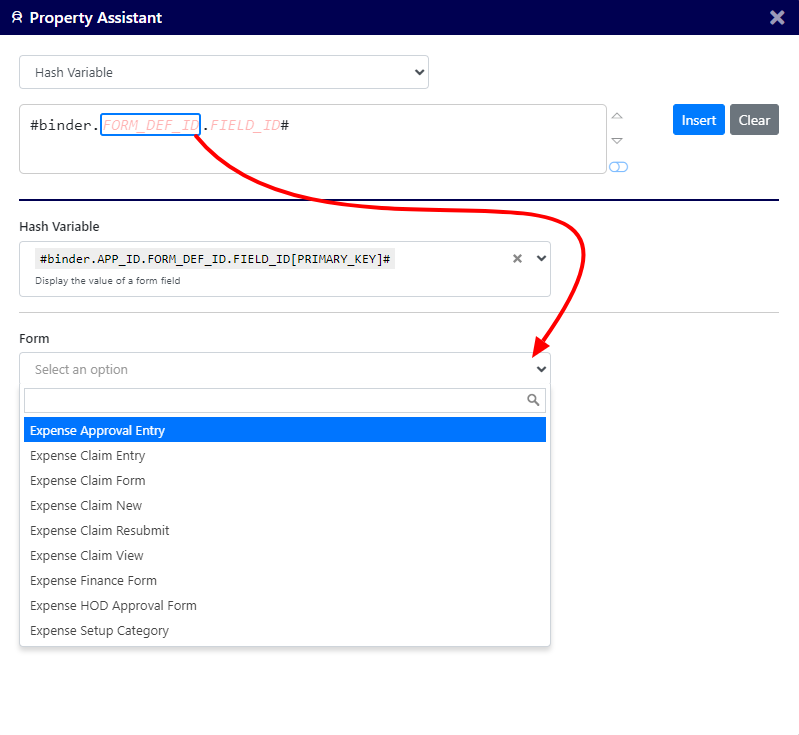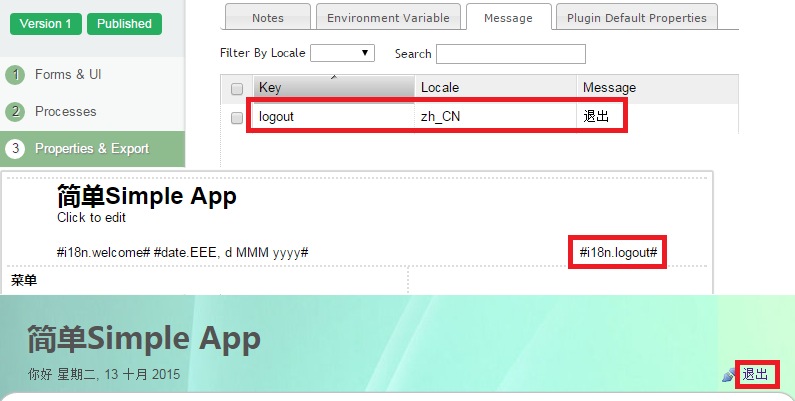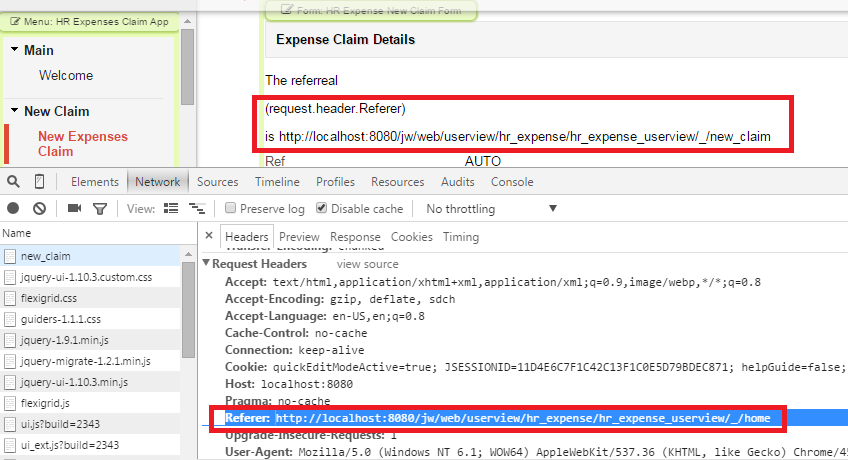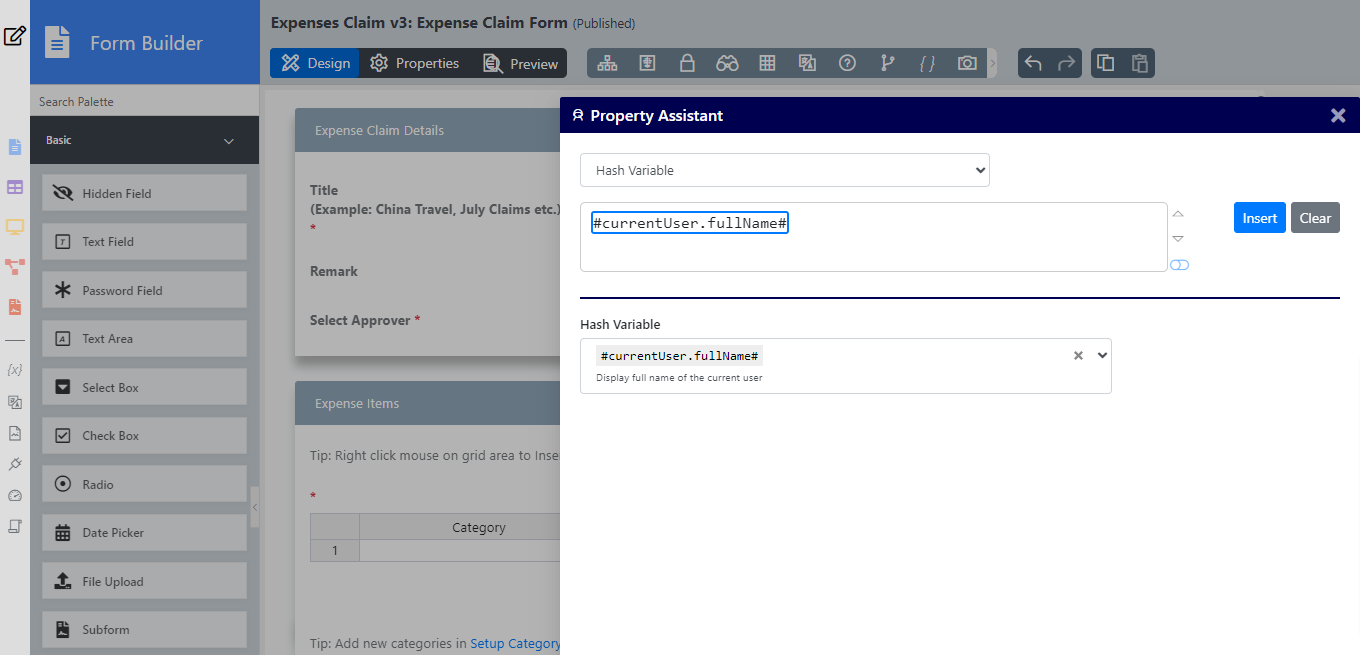Introduction
What are Hash Variables?
Hash Variables give users greater flexibility and freedom in accessing useful information or relevant run-time values from the system.
A hash variable is a special hash-escaped keyword that can be used in :
- Form Builder
- List Builder
- UI Builder
- BeanShell code
- Supported plugin configuration properties
- Activity name in Workflow Designer
- External Form URL when mapping an activity to an external form
to return the value of some useful runtime variables from Joget components. Download the hash variable demonstration app for a quick look.
Nested Hash Variable
A Hash Variable can be used inside another Hash Variable to form a Nested Hash Variable.
The syntax for the inner Hash Variable is wrapped by a pair of {curly bracket}.
#prefix.{prefix.variableKey}#
Here are some examples:
#date.{envVariable.dateFormat}#
#user.{variable.username}.firstName#
#form.tableChild.field1[{form.tableParent.childId}]#
You can pass an index or primary key value to a Hash Variable for retrieval.
The syntax for the inner Hash Variable is wrapped by a pair of [square brackets] .
#form.myTable.fieldId.[primaryKeyValue]#
Here are some examples:
#form.contact.name[007]# where "007" is the primary key or "id" value of database table "app_fd_contact".
Escaping the Resultant Hash Variable
The parsed/returned Hash Variable may cause incompatibility with the current context/environment such as syntax error in a script. Therefore, one may pass in additional parameters into the hash variable declared to escape certain characters. Before ending a hash variable with a hash "#", add a question mark character "?" followed by the required format, for example "#form.table.photo?img2base64#". You may include multiple by defining semicolon ";" separated values.
- regex - Used to escape regular expression special characters
- json - Used to escape JSON special characters
- javascript - Used to escape Javascript special characters
- html - Used to escape HTML special characters
- xml - Used to escape XML special characters
- java - Used to escape Java special characters
- sql - Used to escape SQL special characters
- url - Used to escape URL special characters
- nl2br - Used to convert new line character to <br> HTML tag
- separator(SEPARATOR_CHARS) - Used to change the default separator ";" to the SEPARATOR_CHARS. eg. ?separator(, ) resulted "abc, def" instead of "abc;def".
- img2base64 - hash variable escape method to convert image tag src in a Rich Text Editor to base64 data string which can be displayed in email (however Gmail does not support Base64).
- expression - Used to escape String characters in nested hash variable that may otherwise conflict with syntax/symbols used in the Expression Hash Variable
- noescape - Used to escape SQL query strings in JDBC binders to prevent the "<>" "not equal" operator from being converted, i.e. disables XSS prevention checking. (Available from Joget DX 7.0.7 and higher.)
Note: The following escape formats will not be checked for XSS prevention: "regex, json, javascript, html, xml, java, sql, url, expression, noescape".
#envVariable.script?java#
#envVariable.script?nl2br;json#
#form.table.users?separator(, )#
Hash Variable Return Values
- If the record does not exist, "#form.table.field#" returns the same = "#form.table.field#". Use the ternary operator ( condition ? exprIfTrue : exprIfFalse ) to check and set to NULL if the return value matches the origin hash variable (if used in BeanShell or Javascript).
- If record exist but field is empty, "#form.table.field#" returns empty = "".
- If record exist and field has value "abc", "#form.table.field#" returns the value = "abc".
Some hash variables listed below are not available in the Joget Community Edition, read the Detailed Plugin Comparison Between Editions for more information.
Hash Variable - Property Assistant
This is a new feature in Joget DX 8.
Property Assistant is a new feature in Joget DX 8, that allows you to quickly access and insert Hash Variables (and others) in any form element, UI element or list.
The Property Assistant allows you to choose a hash variable's attributes from a select box (Figure 1).

Figure 1: Property Assistant - Hash Variable Attributes Selection
You can also insert Nested Hash Variables easily using the Property Assistant by clicking on the desired attribute that will include the nested variable and then clicking back on the variable list to choose a variable to insert. (See Figure 2)

Figure 2: Property Assistant - Nested Hash Variable
List Of Joget DX Hash Variables
Workflow Assignment Hash Variable
| Name | Description |
|---|
| Prefix | assignment |
| Description | To get workflow activity information of the current assignment. |
| Attributes | - #assignment.processId#
- #assignment.processDefId#
- #assignment.processDefIdWithoutVersion#
- #assignment.processName#
- #assignment.processVersion#
- #assignment.processRequesterId#
- #assignment.appId#
- #assignment.activityId#
- #assignment.activityName#
- #assignment.activityDefId#
- #assignment.assigneeId#
|
| Scope of Use | - Elements within and part of a Process.
- Activity Name.
- Form mapped as part of process activity mapping.
- Email Tool configuration as part of process tool mapping.
|
| Sample Attributes | To display the assignee's name: #user.{assignment.assigneeId}.firstName# #user.{assignment.assigneeId}.lastName# |
Workflow Process Hash Variable
A new #process.recordId# hash variable was introduced in Joget DX to retrieve the process database table id (or primary key value) which will return the UUID id value of the process record stored in app_fd_[form_table_name], if the General Settings > Run Process Primary Key is set to "UUID". If the "Run Process Primary Key" option in General Settings is set to "Process instance ID", the "#process.recordId#" will return the same value as "#process.processId#".
Read related documentation:
| Name | Description |
|---|
| Prefix | process |
| Description | To retrieve information of a workflow process instance. |
| Attributes | - #process.recordId#
#process.appId# #process.processId# #process.processDefId# #process.processDefIdWithoutVersion# #process.processName# #process.processVersion# #process.processRequesterId# #process.state# #process.startedTime# #process.limit# #process.due# #process.delay# #process.delayInSeconds# #process.finishTime# #process.timeConsumingFromDateStarted# #process.timeConsumingFromDateStartedInSeconds# #process.activityInst.ACTIVITY_DEF_ID.instanceId# #process.activityInst.ACTIVITY_DEF_ID.name# #process.activityInst.ACTIVITY_DEF_ID.status# #process.activityInst.ACTIVITY_DEF_ID.state# #process.activityInst.ACTIVITY_DEF_ID.type# #process.activityInst.ACTIVITY_DEF_ID.startedTime# #process.activityInst.ACTIVITY_DEF_ID.limit# #process.activityInst.ACTIVITY_DEF_ID.limitInSeconds# #process.activityInst.ACTIVITY_DEF_ID.due# #process.activityInst.ACTIVITY_DEF_ID.delay# #process.activityInst.ACTIVITY_DEF_ID.delayInSeconds# #process.activityInst.ACTIVITY_DEF_ID.finishTime# #process.activityInst.ACTIVITY_DEF_ID.timeConsumingFromDateStarted# #process.activityInst.ACTIVITY_DEF_ID.timeConsumingFromDateStartedInSeconds# #process.activityInst.ACTIVITY_DEF_ID.performer# #process.activityInst.ACTIVITY_DEF_ID.performerUser# #process.activityInst.ACTIVITY_DEF_ID.assignmentUsers#
#process.appId[PROCESS_INSTANCE_ID]# #process.processDefId[PROCESS_INSTANCE_ID]# #process.processDefIdWithoutVersion[PROCESS_INSTANCE_ID]# #process.processName[PROCESS_INSTANCE_ID]# #process.processVersion[PROCESS_INSTANCE_ID]# #process.processRequesterId[PROCESS_INSTANCE_ID]# #process.startedTime[PROCESS_INSTANCE_ID]# #process.limit[PROCESS_INSTANCE_ID]# #process.due[PROCESS_INSTANCE_ID]# #process.delay[PROCESS_INSTANCE_ID]# #process.delayInSeconds[PROCESS_INSTANCE_ID]# #process.finishTime[PROCESS_INSTANCE_ID]# #process.timeConsumingFromDateStarted[PROCESS_INSTANCE_ID]# #process.timeConsumingFromDateStartedInSeconds[PROCESS_INSTANCE_ID]# #process.activityInst.ACTIVITY_DEF_ID.instanceId[PROCESS_INSTANCE_ID]# #process.activityInst.ACTIVITY_DEF_ID.name[PROCESS_INSTANCE_ID]# #process.activityInst.ACTIVITY_DEF_ID.status[PROCESS_INSTANCE_ID]# #process.activityInst.ACTIVITY_DEF_ID.state[PROCESS_INSTANCE_ID]# #process.activityInst.ACTIVITY_DEF_ID.type[PROCESS_INSTANCE_ID]# #process.activityInst.ACTIVITY_DEF_ID.startedTime[PROCESS_INSTANCE_ID]# #process.activityInst.ACTIVITY_DEF_ID.limit[PROCESS_INSTANCE_ID]# #process.activityInst.ACTIVITY_DEF_ID.limitInSeconds[PROCESS_INSTANCE_ID]# #process.activityInst.ACTIVITY_DEF_ID.due[PROCESS_INSTANCE_ID]# #process.activityInst.ACTIVITY_DEF_ID.delay[PROCESS_INSTANCE_ID]# #process.activityInst.ACTIVITY_DEF_ID.delayInSeconds[PROCESS_INSTANCE_ID]# #process.activityInst.ACTIVITY_DEF_ID.finishTime[PROCESS_INSTANCE_ID]# #process.activityInst.ACTIVITY_DEF_ID.timeConsumingFromDateStarted[PROCESS_INSTANCE_ID]# #process.activityInst.ACTIVITY_DEF_ID.timeConsumingFromDateStartedInSeconds[PROCESS_INSTANCE_ID]# #process.activityInst.ACTIVITY_DEF_ID.performer[PROCESS_INSTANCE_ID]# #process.activityInst.ACTIVITY_DEF_ID.performerUser[PROCESS_INSTANCE_ID]# #process.activityInst.ACTIVITY_DEF_ID.assignmentUsers[PROCESS_INSTANCE_ID]#
|
| Scope of Use | - Elements within and part of a Process.
- Activity Name.
- Form mapped as part of process activity mapping.
- Email Tool configuration as part of process tool mapping.
|
| Sample Attributes | To display the performer username of an activity instance of a process instance: #process.activityInst.assign.performerUser[{assignment.processId}]# |
Current User Hash Variable
| Name | Description |
|---|
| Prefix | currentUser |
| Description | To retrieve currently logged in user information. More user hash variables here. |
| Attributes | - #currentUser.username#
- #currentUser.firstName#
- #currentUser.lastName#
- #currentUser.fullName#
- #currentUser.email#
- #currentUser.active#
- #currentUser.timeZone#
- #currentUser.locale#
- #currentUser.roles#
In Joget Enterprise edition, these additional attributes are available:- User Meta Employment - #currentUser.employee.code#
- #currentUser.employee.jobTitle#
- #currentUser.employee.isHod#
HOD - #currentUser.hod.username#
- #currentUser.hod.firstName#
- #currentUser.hod.lastName#
- #currentUser.hod.email#
- #currentUser.hod.active#
- #currentUser.hod.timeZone#
Organization - #currentUser.organization.id#
- #currentUser.organization.name#
- #currentUser.organization.description#
Department - #currentUser.department.id#
- #currentUser.department.name#
- #currentUser.department.description#
Department HOD - #currentUser.department.hod.username#
- #currentUser.department.hod.firstName#
- #currentUser.department.hod.lastName#
- #currentUser.department.hod.email#
- #currentUser.department.hod.active#
- #currentUser.department.hod.timeZone#
Grade - #currentUser.grade.id#
- #currentUser.grade.name#
- #currentUser.grade.description#
Group - #currentUser.groups.id#
- #currentUser.groups.name#
|
| Scope of Use | - All components within the App.
|
Date Hash Variable
| Name | Description |
|---|
| Prefix | date |
| Description | To get date time according to a specified format. |
| Attributes |
The above date hash with format control will use the login user's time zone setting and automatically adjust the date and time. If the user's time zone setting is blank, it wil revert to the System Settings "System Time Zone" property. If you want to perform a date formatting without using the time zone value, download and import the Date Formatter Hash Variable plugin from Joget Marketplace.
use "#dateEN.dateFormat" to force the date to be displayed in English. This is a new feature in DX 8.
|
| Scope of Use | - All components within the App.
|
| Sample Attributes | #date.h:mm a# // shows current time of 12:08 PM #dateEN.yyyy-MM-dd# // shows current date of 2023-02-15 in English even though the locale has been set to a different language. (i.e Arabic) #date.EEE,d MMM yyyy h:mm:ss a# // shows current date time of Wed, 4 Jul 2014 12:08:56 PM #date.DAY+7.EEE,d MMM yyyy h:mm:ss a# // Add 7 days on top of current date time - Wed, 11 Jul 2014 12:08:56 PM #date.DAY-1.EEE,d MMM yyyy h:mm:ss a# // Minus 1 days on top of current date time - Wed, 3 Jul 2014 12:08:56 PM #date.dd-MM-yyyy[{form.j_expense_claim.title}|yyyy-MM-dd]# // Retrieves date from j_expense_claim table, form field title, changes its origin format of yyyy-MM-dd to dd-MM-yyyy. |
Environment Variable Hash Variable
| Name | Description |
|---|
| Prefix | envVariable |
| Description | To retrieve Environment Variable values. |
| Attributes | |
| Scope of Use | - Anywhere within the Joget app itself. (i.e. Process, Process Tool, Form, List, UI)
|
| Sample Attributes | #envVariable.smtpServer##envVariable.smtpPort#
|
App Variable Hash Variable
This is a new feature in Joget DX.
| Name | Description |
|---|
| Prefix | appVariable |
| Description | To retrieve App Variable values. |
| Attributes | |
| Scope of Use | - Anywhere within the Joget app itself. (i.e. Process, Process Tool, Form, List, UI)
|
| Sample Attributes | #appVariable.smtpServer#
#appVariable.smtpPort# |
| Name | Description |
|---|
| Prefix | form |
| Description | To get field value from form table. |
| Attributes | - #form.tableName.fieldId #
- #form.tableName.fieldId [recordId]# (Available in v3.1 and above)
|
| Scope of Use | - In a Process Tool part of a Process.
- In a Form.
- In a process design.
|
| Sample Attributes | #form.registration.registeredDate# //will use the current record ID
#form.registration.registeredDate[ 0001 ]# //0001 is the record ID to seek for
#form.registration.registeredDate[{variable.recordId}]#
|
| Name | Description |
|---|
| Prefix | binder |
| Description | To get field value or field value label from the binder of a form via its form definition id . The 'binder' prefix retrieves the field value, while the 'binder.options' prefix retrieves the lookup field (eg. select box, checkbox & radio button) option label. The field value or field value label can also be obtained from other apps by including the APP_ID, else it uses the current app context. By providing the PRIMARY_KEY argument, field value or field value label from a different record can be retrieved, else data from the current record id is retrieved instead. |
| Attributes | - #binder.APP_ID.FORM_DEF_ID.FIELD_ID#
- #binder.APP_ID.FORM_DEF_ID.FIELD_ID[PRIMARY_KEY]#
- #binder.FORM_DEF_ID.FIELD_ID#
- #binder.FORM_DEF_ID.FIELD_ID[PRIMARY_KEY]#
- #binder.options.APP_ID.FORM_DEF_ID.FIELD_ID#
- #binder.options.APP_ID.FORM_DEF_ID.FIELD_ID[PRIMARY_KEY]#
- #binder.options.FORM_DEF_ID.FIELD_ID#
- #binder.options.FORM_DEF_ID.FIELD_ID[PRIMARY_KEY]#
|
| Scope of Use | - In a Process Tool part of a Process.
- In a Form.
- In a process design.
|
| Sample Attributes | #binder.addCard.title# #binder.cardViewer.addCard.title# #binder.cardViewer.addCard.title[b30bce20-c0a82095-14976e70-fded1735]# #binder.options.addCard.title# #binder.options.cardViewer.addCard.title# #binder.options.cardViewer.addCard.title[b30bce20-c0a82095-14976e70-fded1735]# |
App Definition Hash Variable
| Name | Description |
|---|
| Prefix | appDef |
| Description | To retrieve App Definition information |
| Attributes | #appDef.appId# #appDef.dateCreated# #appDef.dateModified# #appDef.version# #appDef.license# #appDef.name# #appDef.published# - #appDef.description# (Properties & Export > Notes)
|
| Scope of Use | - All components within the App.
|
| Sample Attributes | To display the app definition name: #appDef.name# |
App Translation Hash Variable (Internationalization)
| Name | Description |
|---|
| Prefix | i18n |
| Description | To support language localization on application level. |
| Attributes | |
| Scope of Use | - All components within the App.
|
| Sample Attributes | #i18n.logout# 
|
| Example | Please see Add Translation. |
| Name | Description |
|---|
| Prefix | performer |
| Description | To get user information of the performer of an activity. |
| Attributes | - #performer.activityDefId.id#
- #performer.activityDefId.username#
- #performer.activityDefId.firstName#
- #performer.activityDefId.lastName#
- #performer.activityDefId.email#
- #performer.activityDefId.active#
- #performer.activityDefId.timeZone#
|
| Scope of Use | - Elements within and part of a Process.
- Activity Name.
- Form mapped as part of process activity mapping.
- Email Tool configuration as part of process tool mapping.
|
| Sample Attributes | - #performer.runProcess.firstName#
- #performer.submitLeave.firstName#
|
Request Parameter Hash Variable
| Name | Description |
|---|
| Prefix | requestParam |
| Description | To access request parameter' values. |
| Attributes | - #requestParam.parameterName[separator]#
- Separator (, or ;) can be indicated if requestParam is used in List filter with multiple values, to define the separator character in data output. Comma "," is used as default if no separator is indicated in cases of multiple values.
|
| Scope of Use | - All components within the App.
|
| Sample Attributes | - #requestParam.key# can be used specifically to obtain UI Key value.
- #requestParam.name[;]# to indicate 'name' variable will store multiple values separated by semicolon. For example, this SQL statement "select * from expenses where title in (#requestParam.title[,]#)" will be translated to "select * from expenses where title in (a,b,c)" to cater for multiple values in "where-in" statement.
- In a UI page, one may access the following attributes.
- #requestParam.key#
- #requestParam.userviewId#
- #requestParam.menuId#
- #requestParam.appId#
#requestParam.primaryKey# can be used to retrieve the value passed into Ajax Subforms. For example, when a select box is selected, the id value will be passed into the Ajax Subform and you can use the #requestParam.primaryKey# in JDBC SQL Where clause.
|
User Hash Variable
| Name | Description |
|---|
| Prefix | user |
| Description | To get user information based on username. Replace the username below in red with the actual username (example admin) or {currentUser.username}. |
| Attributes | - #user.username.username#
- #user.username.firstName#
- #user.username.lastName#
- #user.username.fullName#
- #user.username.email#
- #user.username.active#
- #user.username.timeZone#
In Joget Enterprise edition, these additional attributes are available:- User Meta - #user.username.meta.KEY#
To read additional user meta data stored in dir_user_meta table.
Example: #user.cat.meta.duration# will return the value "100".

Organization - #user.username.organization.id#
- #user.username.organization.name#
- #user.username.organization.description#
Department - #user.username.department.id#
- #user.username.department.name#
- #user.username.department.description#
Grade - #user.username.grade.id#
- #user.username.grade.name#
- #user.username.grade.description#
- #user.username.grade.organizationId#
HOD - #user.username.hod.username#
- #user.username.hod.firstName#
- #user.username.hod.lastName#
- #user.username.hod.email#
- #user.username.hod.active#
- #user.username.hod.timeZone#
Group - #user.username.groups.id#
- #user.username.groups.name#
Employment - #user.username.employee.code#
- #user.username.employee.jobTitle#
- #user.username.employee.isHod#
Department HOD - #user.username.department.hod.username#
- #user.username.department.hod.firstName#
- #user.username.department.hod.lastName#
- #user.username.department.hod.email#
- #user.username.department.hod.active#
- #user.username.department.hod.timeZone#
|
| Scope of Use | - All components within the App.
|
| Sample Attributes | - #user.admin.groups.name#
- #user.{currentUser.username}.groups.name#
- #user.admin.email#
- #user.{currentUser.username}.email#
- #user.cat.firstName#
- #user.{requestParam.username}.email# to retrieve the email address of the user passed via url parameter
|
Userview Key Hash Variable
| Name | Description |
|---|
| Prefix | userviewKey |
| Description | Userview Key Hash Variable is used solely for the purpose of accessing the current UI key's value. Typical use case for this hash variable are:- - Filtering a List based on UI Key.
- Preloading certain form data field (e.g. subform) in a Form or Form part of a process flow based on UI Key.
|
| Attributes | |
| Scope of Use | |
Workflow Variable Hash Variable
| Name | Description |
|---|
| Prefix | variable |
| Description | To get the value of a workflow variable in a Process Flow. |
| Attributes | |
| Scope of Use | - Elements within and part of a Process.
- Activity Name.
- Form mapped as part of process activity mapping.
- Email Tool configuration as part of process tool mapping.
|
| Sample Attributes | #variable.approvalStatus# |
Request Hash Variable
| Name | Description |
|---|
| Prefix | request |
| Description | To get the value from the current HttpServletRequest object of the page view. |
| Attributes | - #request.domainURL# Short syntax to retrieve the URL scheme and host name, for example "http://localhost:8080". (Available from Joget DX v7.0.8 and higher.)
- #request.baseURL# Short syntax to retrieve the URL scheme, for example "http://localhost:8080/jw". (Available from Joget DX v7.0.8 and higher.)
- #request.characterEncoding#
- #request.contextPath#
- #request.header.NAME# , where NAME is the custom header name.
- #request.locale#
- #request.method#
- #request.pathInfo#
- #request.protocol#
- #request.queryString#
- #request.remoteAddr#
- #request.requestURI#
- #request.requestURL#
- #request.requestedSessionId#
- #request.scheme#
- #request.serverName#
- #request.serverPort#
- #request.servletPath#
|
| Scope of Use | - All components within the App where there is valid HttpServletRequest object. Such object will not be available in background activity such as in Process Tool triggered as a result of Deadlines.
|
| Sample Attributes | 
To retrieve the "Referer" header attribute value in the screenshot above, one may use the following hash variable. See following example of retrieving a Joget APP URL using the Request Hash Variable.
#request.scheme#://#request.serverName#:#request.serverPort##request.contextPath#/web...
|
| Name | Description |
|---|
| Prefix | platform |
| Description | To retrieve platform specific information. |
| Attributes | #platform.name# #platform.version# #platform.jdbcDriver# #platform.setting.dataFileBasePath# #platform.setting.deadlineCheckerInterval# #platform.setting.defaultUserview# #platform.setting.fileSizeLimit# #platform.setting.landingPage# #platform.setting.systemDateFormat# #platform.setting.systemLocale# #platform.setting.systemTimeZone#
|
| Attributes For SMTP | - #platform.setting.smtpHost#
- #platform.setting.smtpPort#
- #platform.setting.smtpSecurity#
- #platform.setting.smtpUsername#
- #platform.setting.smtpPassword#
- #platform.setting.smtpEmail#
|
Additional attributes for
Joget Enterprise &
Professional editions | #platform.license.name# #platform.license.holder# #platform.license.users# #platform.license.appLimit# #platform.license.expiry# #platform.license.activated# #platform.systemKey#
|
| Scope of Use | - All components within the App.
|
Users Hash Variable
| Name | Description |
|---|
| Prefix | users |
| Description | To retrieve information of all the users in the selected group, grade, department and organization. Multiple results will be separated by semicolon. |
| Attributes | #users.group.GROUP_ID.username# #users.group.GROUP_ID.firstName# #users.group.GROUP_ID.lastName# #users.group.GROUP_ID.fullName# #users.group.GROUP_ID.email#
#users.grade.GRADE_ID.username# #users.grade.GRADE_ID.firstName# #users.grade.GRADE_ID.lastName# #users.grade.GRADE_ID.fullName# #users.grade.GRADE_ID.email#
#users.department.DEPARTMENT_ID.username# #users.department.DEPARTMENT_ID.firstName# #users.department.DEPARTMENT_ID.lastName# #users.department.DEPARTMENT_ID.fullName# #users.department.DEPARTMENT_ID.email#
#users.organization.ORGANIZATION_ID.username# #users.organization.ORGANIZATION_ID.firstName# #users.organization.ORGANIZATION_ID.lastName# #users.organization.ORGANIZATION_ID.fullName# #users.organization.ORGANIZATION_ID.email#
|
| Scope of Use | - All components within the App.
|
| Sample Attributes | To return all the users in the current user's groups id: |
Bean Shell Hash Variable
| Name | Description |
|---|
| Prefix | beanshell |
| Description | Using App Variable to execute bean shell script. Passing parameter using URL query string syntax. |
| Attributes | |
| Scope of Use | - All components within the App.
|
| Sample Attributes | To execute a script stored in the "welcome" app variable with parameter "username" and "dept":
if (username != null && username.length == 1 && !username[0].isEmpty()) {
return "Welcome " + username[0] + " (" + dept[0] + "),";
} else {
return "";
}
|
| Related Tutorials | |
Datalist Hash Variable
The "datalist.col" (highlighted in Bold in the table below) Hash Variables are a new feature in DX 8 that allows users to access and display a List's column data in multiple formats.
| Name | Description |
|---|
| Prefix | datalist |
| Description | To display the List records in a grid format in your form or email tool. |
| Attributes | - #datalist.html.ID#
- #datalist.csv.ID#
- #datalist.size.ID#
- #datalist.total.ID#
- #datalist.json.ID#
- #datalist.col.csv.ID.column#
- #datalist.col.sum.ID.column#
- #datalist.col.avg.ID.column#
- #datalist.col.csv.ID.column[FILTER_PARAMETERS]#
- #datalist.col.sum.ID.column[FILTER_PARAMETERS]#
- #datalist.col.avg.ID.column[FILTER_PARAMETERS]#
- #datalist.html.ID[FILTER_PARAM1=FILTER_VALUE1&FILTER_PARAM2=FILTER_VALUE2]#
- #datalist.csv.ID[FILTER_PARAM1=FILTER_VALUE1&FILTER_PARAM2=FILTER_VALUE2]#
- #datalist.size.ID[FILTER_PARAM1=FILTER_VALUE1&FILTER_PARAM2=FILTER_VALUE2]#
- #datalist.total.ID[FILTER_PARAM1=FILTER_VALUE1&FILTER_PARAM2=FILTER_VALUE2]#
|
| Scope of Use | - All components within the App.
|
| Sample Attributes | - #datalist.html.myDataList#
- #datalist.csv.ImyDataList#
- #datalist.size.ImyDataList#
- #datalist.total.ImyDataList#
- #datalist.html.myDataList[d-8015999-fn_name=James&d-6304176-fn_email=james@gmail.com]#
- #datalist.csv.myDataList[d-8015999-fn_name=James&d-6304176-fn_email=james@gmail.com]#
- #datalist.size.myDataList[d-8015999-fn_name=James&d-6304176-fn_email=james@gmail.com]#
- #datalist.total.myDataList[d-8015999-fn_name=James&d-6304176-fn_email=james@gmail.com]#
- #datalist.html.list_f1[d-1338250-fn_id={process.recordId}]#
- #datalist.html.listId[filterId={form.table.field[{envVariable.variableId}]}]#
|
Expression Hash Variable
| Name | Description |
|---|
| Prefix | exp |
| Description | Mathematical and string operations on hash variables |
| Attributes | #exp.variable# |
| Scope of Use | - All components within the App.
|
| Sample Attributes | Testing Values - #envVariable.num1# = 55
- #envVariable.num2# = 288
- #envVariable.double1# = 123.45
- #envVariable.double2# = 246.78
- #envVariable.bool1# = true
- #envVariable.bool2# = false
- #envVariable.str1# = Hello World!
- #envVariable.str2# = Using Joget Hash Variables!
- #envVariable.empty# =
- #envVariable.hashVariable# = #assignment.processId#
Mathematical operators - #exp.{envVariable.num1} + {envVariable.num2}# = 343
- #exp.{envVariable.num1} - {envVariable.num2}# = -233
- #exp.{envVariable.double1} * {envVariable.double2}# = 30464.991
- #exp.{envVariable.num2} / {envVariable.num1}# = 5
- #exp.{envVariable.num1} % 7# = 6
- #exp.({envVariable.num1} + 2) * 2# = 114
- #exp.{envVariable.num1} + 2 * 2# = 59
- #exp.2 ^ 2# = 4
Logical operators - #exp.{envVariable.bool1} and {envVariable.bool2}# = false
- #exp.{envVariable.bool1} or {envVariable.bool2}# = true
- #exp.!{envVariable.bool1}# = false
Relational operators - #{envVariable.num1} gt {envVariable.num2}# = false
- #{envVariable.num1} ge {envVariable.num1}# = true
- #{envVariable.num1} lt {envVariable.num2}# = true
- #{envVariable.num1} le {envVariable.num1}# = true
- #{envVariable.num1} eq {envVariable.num1}# = true
- #{envVariable.num1} ne {envVariable.num1}# = false
Ternary Operator (If Else) - #exp.({envVariable.num1} lt {envVariable.num2})?{envVariable.num1}:{envVariable.num2}#= 55
- #exp.'{envVariable.empty?expression}'.isEmpty()?'empty':'has value'#= empty
String methods Note: Basically most of the String methods can be used, using `?expression` to escape single quote in value. - #exp.'{envVariable.str1?expression}' + ' ' + '{envVariable.str2?expression}'# = Hello World! Using Joget Hash Variables
- #exp.'{envVariable.str1?expression}'.substring(5)# = World!
- #exp.'{envVariable.str1?expression}'.toLowerCase()# = hello world!
- #exp.'{envVariable.str1?expression}'.toUpperCase()# = HELLO WORLD!
- #exp.'{envVariable.str1?expression}'.replace('world', 'there')# = Hello World!
- #exp.'{envVariable.str1?expression}'.replaceFirst('[a-z]', '*')# = H*llo World!
- #exp.'{envVariable.str1?expression}'.replaceAll('[a-z]', '*')# = H**** W****!
- #exp.'{envVariable.str1?expression}'.charAt(0)# = H
- #exp.'{envVariable.str1?expression}'.contains('World')# = true
- #exp.'{envVariable.str1?expression}'.equalsIgnoreCase('{envVariable.str1?expression}'.toLowerCase())# = true
- #exp.'{envVariable.empty?expression}'.isEmpty()# = true
- #exp.'{envVariable.str1?expression}'.indexOf('World')# = 6
- #exp.'{envVariable.str1?expression}'.lastIndexOf('World')# = 6
- #exp.'{envVariable.str1?expression}'.startsWith('H')# = true
- #exp.'{envVariable.str1?expression}'.endsWith('!')# = true
Custom Methods - #exp.$isParsed('{envVariable.hashVariable}')# = false
Math methods Note: All java.lang.Math methods can be used. - #exp.$sin(30)# = -0.9880316240928618
- #exp.$cos(30)# = 0.15425144988758405
- #exp.$tan(30)# = -6.405331196646276
- #exp.$asin(30)# = NaN
- #exp.$acos(30)# = NaN
- #exp.$atan(30)# = 1.5374753309166493
- #exp.$sinh(30)# = 5.343237290762231E12
- #exp.$cosh(30)# = 5.343237290762231E12
- #exp.$tanh(30)# = 1.0
- #exp.$abs(-7)# = 7.0
- #exp.$max(60,30)# = 60.0
- #exp.$min(60,30)# = 30
- #exp.$round(79.52)# = 80
- #exp.$sqrt(12)# = 3.4641016151377544
- #exp.$cbrt(81)# = 4.326748710922225
- #exp.$pow(4, 2)# = 16.0
- #exp.$signum(82.7)# = 1.0
- #exp.$ceil(82.7)# = 83.0
- #exp.$copySign(740.4, -29.1)# = -740.4
- #exp.$nextAfter(84352.24, 154.284)# = 84352.234
- #exp.$nextUp(744.93)# = 744.93005
- #exp.$nextDown(744.93)# = 744.9299999999998
- #exp.$floor(744.93)# = 744.0
- #exp.$floorDiv(25, 3)# = 8
- #exp.$random()# = 0.3988245190916774
- #exp.$rint(81.68)# = 82.0
- #exp.$hypot(8, 6)# = 10.0
- #exp.$ulp(8.1)# = 9.536743E-7
- #exp.$getExponent(50.45)# = 5
- #exp.$IEEEremainder(387.1, 4.2)# = 0.7000000000000064
- #exp.$addExact(469, 737)# = 1206
- #exp.$subtractExact(469, 737)# = -268
- #exp.$multiplyExact(469, 737)# = 345653
- #exp.$incrementExact(674)# = 675
- #exp.$decrementExact(674)# = 673
- #exp.$negateExact(674)# = -674
- #exp.$toIntExact(-829)# = -829
- #exp.$log(38.9)# = 3.6609942506244004
- #exp.$log10(38.9)# = 1.5899496013257077
- #exp.$log1p(26)# = 3.295836866004329
- #exp.$exp(2)# = 7.38905609893065
- #exp.$expm1(2)# = 6.38905609893065
- #exp.$toDegrees(5)# = 286.4788975654116
- #exp.$toRadians(180.0)# = 3.141592653589793
|
Report Builder Hash Variable
| Name | Description |
|---|
| Prefix | reportLink |
| Description | To retrieve the particular report based on the reportId. To know more about Report Builder, see here. |
| Attributes | |
| Scope of Use | - All components within the App.
|
| Sample Attributes | - #reportLink.financialReport#
|
Code Builder Hash Variable
| Name | Description |
|---|
| Prefix | code |
| Description | To retrieve the template based on the code snippet ID. |
| Attributes | |
| Scope of Use | - All components within the App.
|
| Sample Attributes | - #code.cs-calculationScript#
|
Hash Variables In Joget Marketplace
Download Demo App
APP_hash_variable_dx_kb.jwa





